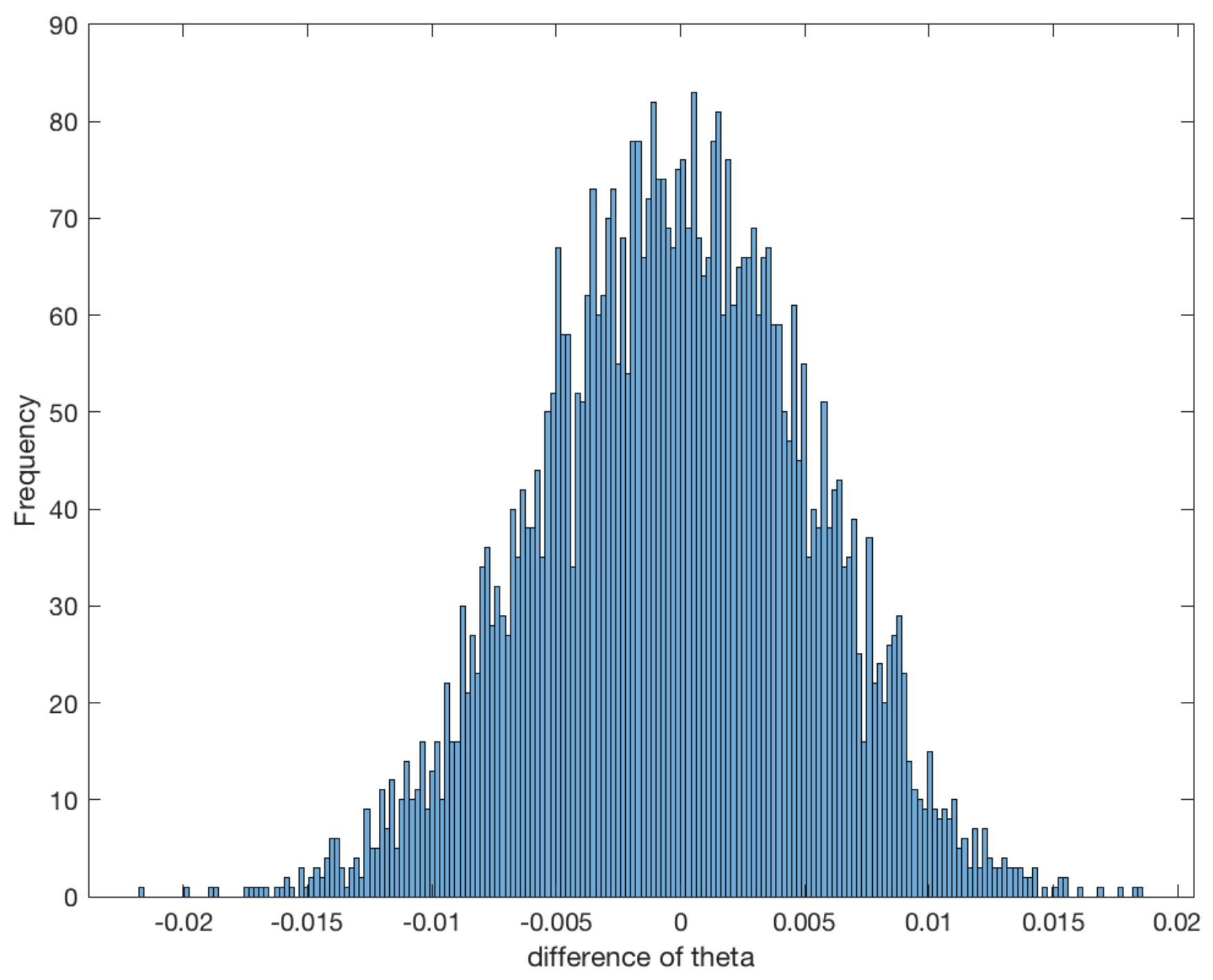Controlled Parameter Estimation for The AR(1) Model with Stationary Gaussian Noise
Abstract
1. Introduction
2. Preliminaries and Notations
2.1. Stationary Gaussian Sequences
2.2. Model Transformation
2.3. Fisher Information
3. Main Results
- is strong consistency, that is, as .
- is uniformly consistent on compact , i.e. for any
- is uniformly on compacts asymptotically normal, i.e., as ,where ξ is a zero mean Gaussian random variable with variance defined in Theorem 1. Moreover, we have the uniform on convergence of the moments: for any ,
4. Simulation Study
5. Conclusions
Author Contributions
Funding
Institutional Review Board Statement
Informed Consent Statement
Data Availability Statement
Acknowledgments
Conflicts of Interest
Appendix A
Appendix A.1. Proof of Theorem 1
Appendix A.2. Proof of Theorem 2
References
- Kiefer, J. On the Efficient Design of Statistical Investigation. Ann. Stat. 1974, 2, 849–879. [Google Scholar]
- Mehra, R. Optimal Input Signal for Linear System Identification. IEEE Trans. Autom. Control 1974, 19, 192–200. [Google Scholar] [CrossRef]
- Mehra, R. Optimal Inputs Signal for Parameter Estimation in Dynamic Systems-Survey and New Results. IEEE Trans. Autom. Contrl 1974, 19, 753–768. [Google Scholar] [CrossRef]
- Ng, T.S.; Qureshi, Z.H.; Cheah, Y.C. Optimal Input Design for An AR Model with Output Constraints. Automatica 1984, 20, 359–363. [Google Scholar] [CrossRef]
- Gevers, M. From the Early Achievement to the Revival of Experiment Design. Eur. J. Control 2005, 11, 1–18. [Google Scholar] [CrossRef]
- Goodwin, G.; Rojas, C.; Welsh, J.; Feuer, A. Robust Optimal Experiment Design for System Indentification. Automatica 2007, 43, 993–1008. [Google Scholar]
- Ljung, L. System Identification-Theory for the User; Prentice Hall: Englewood Cliffs, NJ, USA, 1987. [Google Scholar]
- Ovseevich, A.; Khasminskii, R.; Chow, P. Adaptative Design for Estimation of Unknown Parameters in Linear System. Probl. Inf. Transm. 2000, 36, 125–153. [Google Scholar]
- Leland, W.E.; Taqqu, M.S.; Willinger, W.; Wilson, D.V. On the Self-similar Nature of Ethernet Traffic. IEEE/ACM Trans. Netw. 1994, 2, 1–15. [Google Scholar] [CrossRef]
- Comte, F.; Renault, E. Long Memory in Continuous-time Stochastic Volatility Models. Math. Financ. 1998, 8, 291–323. [Google Scholar] [CrossRef]
- Gatheral, J.; Jaisson, T.; Rosenbaum, M. Volatility is Rough. Quant. Financ. 2018, 18, 933–949. [Google Scholar] [CrossRef]
- Yajima, Y. On Estimation of Long-Memory Time Series Models. Aust. J. Stat. 1985, 27, 302–320. [Google Scholar] [CrossRef]
- Brouste, A.; Cai, C. Controlled Drift Estimation in Fractional Diffusion Process. Stoch. Dyn. 2013, 13, 1250025. [Google Scholar] [CrossRef]
- Brouste, A.; Marina, K.; Popier, A. Design for Estimation of Drift Parameter in Fractional Diffusion System. Stat. Inference Stoch. Process. 2012, 15, 133–149. [Google Scholar] [CrossRef]
- Cao, K.; Gu, J.; Mao, J.; Liu, C. Sampled-Data Stabilization of Fractional Linear System under Arbitrary Sampling Periods. Fractal Fract. 2022, 6, 416. [Google Scholar] [CrossRef]
- Chen, S.; Huang, W.; Liu, Q. A New Adaptive Robust Sliding Mode Control Approach for Nonlinear Singular Fractional Oder System. Fractal Fract. 2022, 6, 253. [Google Scholar] [CrossRef]
- Jia, T.; Chen, X.; He, L.; Zhao, F.; Qiu, J. Finite-Time Synchronization of Uncertain Fractional-Order Delayed Memristive Neural Networks via Adaptive Sliding Mode Control and Its Application. Fractal Fract. 2022, 6, 502. [Google Scholar] [CrossRef]
- Liu, R.; Wang, Z.; Zhang, X.; Ren, J.; Gui, Q. Robust Control for Variable-Order Fractional Interval System Subject to Actuator Saturation. Fractal Fract. 2022, 6, 159. [Google Scholar] [CrossRef]
- Brouste, A.; Cai, C.; Kleptsyna, M. Asymptotic Properties of the MLE for the Autoregressive Process Coefficients Under Stationary Gaussian Noise. Math. Methods Stat. 2014, 23, 103–115. [Google Scholar] [CrossRef]
- Brouste, A.; Cai, C.; Soltane, M.; Wang, L. Testing for The Change of the Mean-Reverting Parameter of An Autoregressive Model with Stationary Gaussian Noise. Stat. Inference Stoch. Process. 2020, 23, 301–318. [Google Scholar] [CrossRef]
- Brouste, A.; Kleptsyna, M. Kalman Type Filter Under Stationary Noises. Syst. Control Lett. 2012, 61, 1229–1234. [Google Scholar] [CrossRef]
- Robinson, P. Log-periodogram Regression of Time Series with Long-Range Dependence. Ann. Stat. 1995, 23, 1048–1072. [Google Scholar] [CrossRef]
- Istas, J.; Lang, G. Quadratic Variation and Estimation of Local Holder Index of a Gaussian Process. Ann. l’I.H.P. Sect. B 1997, 33, 407–436. [Google Scholar] [CrossRef]
- Ben Hariz, S.; Brouste, A.; Cai, C.; Soltane, M. Fast and Asymptotically-Efficient Estimation in a Fractional Autoregressive Process. 2021. Available online: https://hal.archives-ouvertes.fr/hal-03221391 (accessed on 8 May 2021).
- Liptser, R.S.; Shiryaev, A.N. Statistics of Random Processes II: Applications; Springer: Berlin/Heidelberg, Germany, 2001; Volume 2. [Google Scholar]
- Durbin, J. The Fitting of Time Series Models. Rev. Inst. Int. Stat. 1960, 28, 233–243. [Google Scholar] [CrossRef]
- Sinai, Y.G. Self-Similar Probability Distribution. Theory Probab. Appl. 1976, 21, 64–80. [Google Scholar] [CrossRef]
- Hosking, J. Fractional Differencing. Biometrika 1981, 68, 165–176. [Google Scholar] [CrossRef]
- Chen, Y.; Li, T.; Li, Y. Second Estimator for An AR(1) Model Driven by a Long Momory Gaussian Noise. arXiv, 2020; arXiv:2008.12443. [Google Scholar]
- Wood, A.; Chan, G. Simulation of Stationary Gaussian Processes in [0,1]d. J. Comput. Graph. Stat. 1994, 3, 409–432. [Google Scholar] [CrossRef]
- Kleptsyna, M.L.; Le Breton, A.; Viot, M. New Formulas Concerning Laplace transforms of Quadratic Forms for General Gaussian Sequences. Int. J. Stoch. Anal. 2002, 15, 309–325. [Google Scholar] [CrossRef]


Publisher’s Note: MDPI stays neutral with regard to jurisdictional claims in published maps and institutional affiliations. |
© 2022 by the authors. Licensee MDPI, Basel, Switzerland. This article is an open access article distributed under the terms and conditions of the Creative Commons Attribution (CC BY) license (https://creativecommons.org/licenses/by/4.0/).
Share and Cite
Sun, L.; Cai, C.; Zhang, M. Controlled Parameter Estimation for The AR(1) Model with Stationary Gaussian Noise. Fractal Fract. 2022, 6, 643. https://doi.org/10.3390/fractalfract6110643
Sun L, Cai C, Zhang M. Controlled Parameter Estimation for The AR(1) Model with Stationary Gaussian Noise. Fractal and Fractional. 2022; 6(11):643. https://doi.org/10.3390/fractalfract6110643
Chicago/Turabian StyleSun, Lin, Chunhao Cai, and Min Zhang. 2022. "Controlled Parameter Estimation for The AR(1) Model with Stationary Gaussian Noise" Fractal and Fractional 6, no. 11: 643. https://doi.org/10.3390/fractalfract6110643
APA StyleSun, L., Cai, C., & Zhang, M. (2022). Controlled Parameter Estimation for The AR(1) Model with Stationary Gaussian Noise. Fractal and Fractional, 6(11), 643. https://doi.org/10.3390/fractalfract6110643







